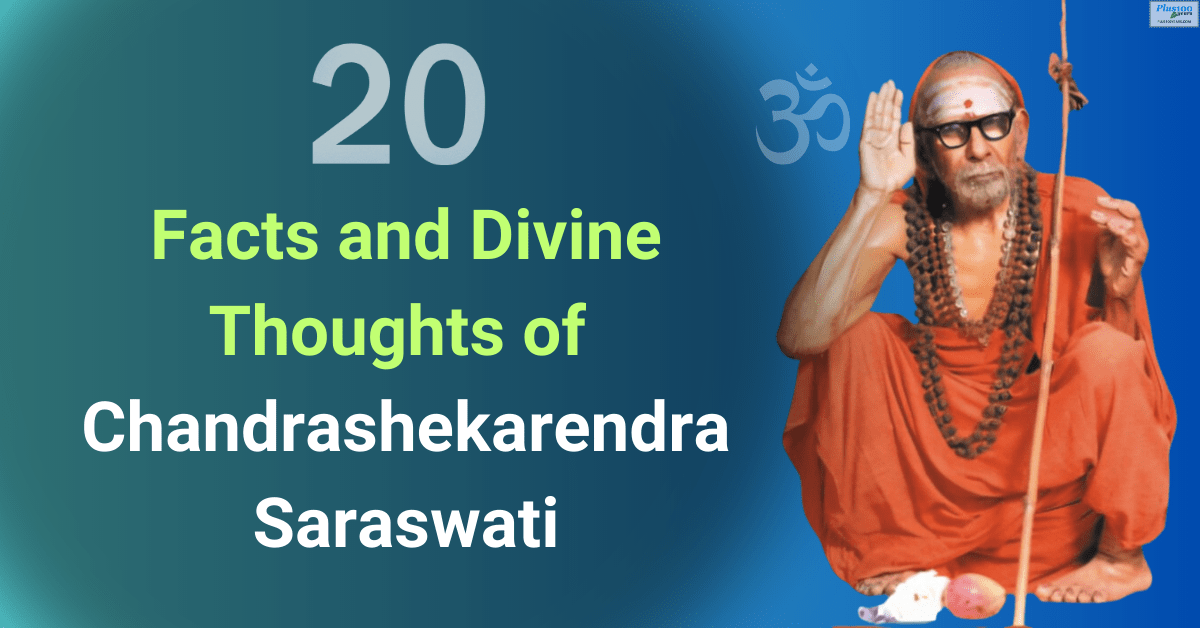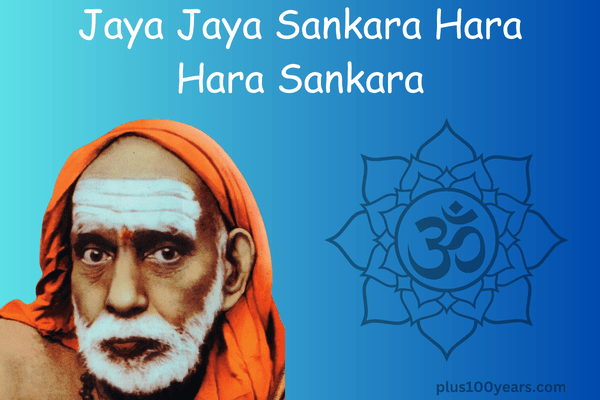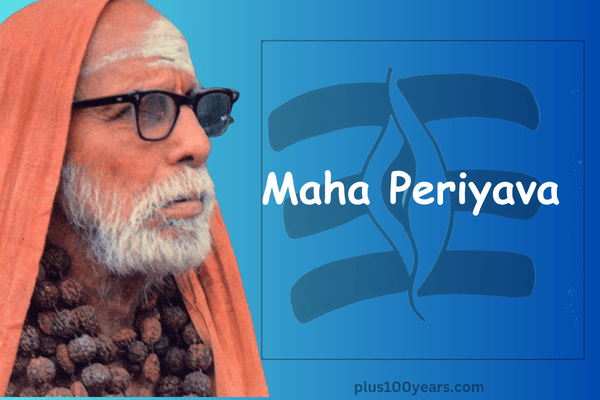
The Kanchi Kamakoti Peetham's 68th Jagadguru Shankaracharya was Jagadguru Shri Chandrasekharendra Saraswati Mahaswamigal (born Swaminathan Sastri; 20 May 1894 - 8 January 1994), also known as the Sage of Kanchi or Mahaperiyavar (meaning "The great elder").
The discourses of Mahaperiyavar is found to be in a Tamil book titled "Deivathin Kural" which is also called Voice of God.
About Chandrasekharendra Saraswati
On May 20, 1894, Mahaperiyava was born in Villupuram, South Arcot District, in the central part of the southern state of Tamil Nadu.
Subrahmanya Sastri's father was born into a Kannada-speaking Smartha Brahmin family that had migrated to Tamil Nadu generations before.
Subrahmanya Sastri entered the educational service and worked as a teacher. Swaminathan was his parents' second child. Sadasiva Sastri was born on October 3, 1903, in Viluppuram, Tamil Nadu's South Arcot District.
Swaminathan's upanayanam was performed in Tindivanam in 1905. He was well-versed in the Vedas and started performing poojas at a young age.
In 1906, Sri Chandrasekharendra Saraswati, the Sixty-sixth Acharya of Kamakoti Pitha, was camping in Perumukkal, a small village near Tindivanam, in observance of the Chaturmasya vrata. At the time, Subrahmanya Sastri went to seek Acharya's blessings.
Swaminathan's maternal cousin was installed as the sixty-seventh Acharya after the sixty-sixth Acharya attained Siddhi at Kalavai. Swaminathan was installed as the Acharya after the sixty-seventh Acharya became ill with a fever.
On February 13, 1907, Swaminathan was ordained as the sixty-eighth Acharya of Kanchi Kamakoti Peetham under the Sannyasa name Chandrasekhara Saraswati.
He was well-versed in the Vedas, Puranas, various Hindu texts, and ancient Indian literature, as is customary for seers. In 1909, Acharya was fifteen years old. He studied under the pandits of the Matha in Kumbakonam for two years.
From 1911 to 1914, he studied in Mahendramangalam, a small village on the Akhanda Kaveri's northern bank. The Acharya was interested in photography, mathematics, and astronomy, among other things. He returned to Kumbakonam in 1914.

Also Read: Interesting Facts About Bhagawan Ramana Maharshi
10 Interesting Facts About Chandrashekarendra Saraswati
1. Chandrashekarendra Saraswati was a highly respected Hindu saint and the 68th Jagadguru of the Kanchi Kamakoti Peetham, one of the most ancient and revered monastic institutions of India.
2. Born in 1894 in the village of Viluppuram in Tamil Nadu, he was given the name Swaminathan by his parents. Later, he was initiated into sainthood and became known as Chandrashekarendra Saraswati.
3. Chandrashekarendra Saraswati was known for his asceticism and his devotion to spiritual practices. He was also known for his erudition, having studied extensively the ancient Hindu scriptures and the Vedas.
4. He was a prolific writer, having authored numerous books on Hindu philosophy, religion, and spirituality. Some of his most famous works include "Hindu Dharma," "Hindu Samaya Aranilai," and "Deivathin Kural."
5. Despite his vast knowledge and learning, he was known for his simplicity and humility. He would often mingle with people from all walks of life, and was always willing to help those in need.
6. Chandrashekarendra Saraswati was a strong advocate for the preservation of Hindu culture and traditions. He spoke out against the conversion of Hindus to other religions and worked tirelessly to promote Hinduism both within India and abroad.
7. He was a vocal critic of the caste system and worked to eliminate the discrimination and prejudice associated with it. He also advocated for the education of women and the eradication of child marriage.
8. He was a staunch supporter of Indian independence and worked closely with Mahatma Gandhi during the Indian independence movement.
9. Chandrashekarendra Saraswati was widely respected by people of all faiths, and his teachings continue to inspire millions of people across the world today.
10. He passed away in 1994 at the age of 100, leaving behind a legacy that continues to influence and guide people toward a more spiritually enlightened way of life.
10 Divine Thoughts Of Chandrasekharendra Saraswati
1. To develop unshakable faith in God is the medicine of Grace to wipe away our sorrows, and tolerance is the medicine of Grace to wipe away our sorrows. Only Bhakti can give us the ability to bear sorrow.
Temples serve as conduits for the development of Bhakti. As a result, temples are required everywhere. All temple offerings to the deities are expressions of our gratitude to God.
2. The source is that which is within all and is perceived as "This." God is he who is within and sees as "This." It is the truth. It is within you. Sadhana is a limited practice; the end is limitless.
3. What is the function of education? Its primary application is to foster humility (vinaya). A disciple who went to a guru was known as a "vineyan" in the past, which means a person of humility, which is the hallmark of the instruction he received from his guru, the fruit of education. Education is meaningless without humility.
Education is still the same as it was before, but the methods have changed. The medicine remains the same, but if the diet is altered, the medicine turns poisonous.
Education is now merely a means of subsistence. The student should go to a guru and follow the guru-kula system for true education.

4. Many acts relating to God are carried out, such as the construction of temples and the excavation of tanks. There would be numerous difficulties in carrying them out. There would also be various forms of dishonor.
They would complete their tasks with mental focus, removing impurities and allowing their minds to wander. They gain mind control by straightening their minds, and in the end, they realize the Reality that is to be known.
Poort tam refers to activities such as digging tanks and constructing temples. Ishtam is the act of performing sacrifices, etc. We get the word Ishtapoortam by combining these two.
5. Make love your sole motivation in everything you do. Any requirement must be related to another. Allow action to be motivated by love. Passions such as desire and hatred, anger and malice must be avoided at all costs.
Most of the world's ills will disappear if love becomes the guiding principle of all actions.
6. We discover Truth through education. There are many truths, one of which is history. One truth is geography, and one truth is mathematics. Truth has the most content in Mathematics. Others contain an element of fantasy.
We come across names like Asia, Africa, Madras, and Calcutta in Geography. We came up with these names. We made up names like "plateau," "valley," and so on.
When we arrive at truth by gradually eliminating all that is fictitious, that Truth is discovered to be God. Education produces the fruit of true devotion to Him.
7. In reality, Parameswara and Sriman Narayana are the same people. They are not the same. This is the unanimous opinion of all the sastras. Names differ, forms differ, and occupations differ, but the reality that exists within Them is the same.
8. What is the significance of human birth? To work, eat, suffer daily misery, and eventually die? Can we not die now instead of working and suffering? The goal of birth is to prevent rebirth. All animals, apart from man, grow horizontally.
Only man develops vertically. Instead of growing horizontally, God intends for him to grow vertically to look up. God gave animals self-defense mechanisms, but only man was given intelligence. We avoid rebirth by doing nothing; we avoid sins by giving up attachment.
9. Any object that is consumed by fire becomes charred. When that black residue is burned again, it turns into white ash. Even when burned again, white ash remains white. This demonstrates that white is the ultimate and black is close to it.
According to science, diamond, and coal are essentially the same thing. White and black do not exist as colors. When subjected to the test of fire, the primary colors separate from the objects to which they are attached and eventually turn white.
Similarly, in the mental and spiritual realms, the Ultimate Reality is Siva, who is white, and Parvati, who is dark, is close by.
The residue is Siva when everything is tested in the fire of Jnana, or true knowledge. The spiritual plane's ash corresponds to the material plane's ash in Siva. We smear sacred ash on our bodies to remind ourselves of Siva and the fact that Siva is the goal of life.
10. Much has been written about the personal God and the impersonal absolute God, both with and without attributes. Only when all the colors in the light combine do we get the colorless rays of the sun.
Similarly, God becomes Nirguna, or attributeless, by virtue of being the abode of attributes.
Message on the Day of Independence
"On this joyous occasion of our country Bharat's independence, the people of this ancient country must pray to Sri Bhagavan wholeheartedly and unanimously."
Let us all pray to God for the mental and physical strength to devote more and more of our time and energy to the pursuit of spiritual knowledge.
"We can only preserve our freedom and help all living beings on Earth live happy lives through the Almighty's grace," Periyava said. "Bhagavan's chakra, the embodiment of Dharma, has a place in the center of our National Flag," he explained.
"This chakra reminds us of Emperor Ashoka's moral values, also known as Devanampriyaha in history." Furthermore, the chakra calls our attention to the spiritual discipline taught by Bhagavan Krishna in the Bhagavad Gita.
Lord Krishna's reference to the Chakra in Verse 16 of the Bhagavad Gita's Third Chapter demonstrates the Dharma that shines in the form of a Chakra.
Chandrasekharendra Saraswati Words of Holiness
"I took a bath at the Kumara Koshta Thirtha. While I was there, a group from the Mutt arrived in a carriage from Kalavai to purchase items for the Maha Puja, which was to be held on the tenth day of the previous 66th Acharya's passing.
One of the members, a hereditary mason of the Mutt, invited me to join them. A separate cart was arranged for my family to follow behind. During the journey, the mason hinted that I might not return home and that I could spend the rest of my life at the Mutt.

At first, I thought my elder cousin, who was now the Head of the Mutt, wanted me to live with him. However, as the cart moved on, the mason gradually revealed the truth: the Acharya had developed a fever that had progressed to delirium, and I was being taken to Kalavai to help care for him.
I was shocked by this unexpected turn of events and could only repeat the prayer "Rama...Rama," which was the only one I knew. Later, my mother and siblings arrived, but instead of consoling her sister, my mother found herself in need of comfort."

Add new comment